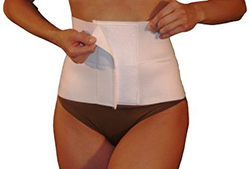
A tummy tuck, also known as abdominoplasty, is a surgical procedure performed to improve the appearance of the abdominal area through the removal of excess skin and fat. It is a popular choice following pregnancy or weight loss. The goal of tummy tuck surgery is to improve the contours around your waistline, leaving you with a flatter more toned stomach.
What to expect after surgery
A tummy tuck is performed with general anesthesia. As the anesthesia wears off, you will probably feel tired, groggy, and nauseous. While most patients return home the same day, you will need someone to drive you. Depending on the extent of the procedure, you may also be required to spend a night or two in the hospital recovering from surgery. Most tummy tuck recovery patients require several days of bed rest even if they return home the same day as their surgery.
The surgeon will have placed a drain to draw fluid away from the incision. The area will also be covered in a surgical dressing and compression garment. Be sure to follow your doctor’s aftercare instructions regarding this drain, as well as any other necessary steps to take during the healing process. If there are sutures holding your incisions closed, these will be removed in a week or two when you return for a follow-up visit to monitor your tummy tuck recovery process.
Immediately following a tummy tuck procedure, expect your abdomen to feel very sore or tender. Any pain you feel can be controlled with pain relievers. Your doctor may also prescribe an antibiotic. Common side effects experienced by abdominoplasty patients include redness, bruising, and swelling. These effects of surgery usually subside in about one to three weeks as your body adjusts to the new contours and the incisions heal.
Tips to reduce swelling
Swelling is among the most common side effects experienced by those who undergo abdominoplasty. Most swelling subsides within about three weeks following surgery, although it is possible for some residual swelling to continue for up to six months. While some degree of swelling is to be expected due to the nature of the surgery, persistent swelling can obscure the results of your tummy tuck. In order to enjoy your flatter stomach faster, here are a few tips to reduce swelling:
- Stay hydrated by drinking plenty of water as you recover.
- Maintain a healthy diet that is low in sodium.
- Get plenty of rest. Return to your daily life gradually, rather than a sudden jump in activity level.
- Gently massage the abdomen to encourage fluid circulation.
- Use ice or cold compresses if directed to do so.
- Wear the compression garment as instructed.
- Tell your doctor about any medications you are taking, as some can interfere with fluid balance.
Compression garments
Most patients wear a compression garment over the abdomen immediately following the surgery. This elastic garment holds the tissues very close to the body, helping the skin adjust to the new contours of the abdomen. Wearing your compression garment as directed reduces the likelihood of loose or sagging skin after an abdominoplasty. The compression garment also helps to control swelling, resulting in a shorter tummy tuck recovery period.
Healing time
Expect the initial tummy tuck recovery phase to last several weeks, during which time your abdomen will feel uncomfortable. Plan to take about two weeks off from work, depending on the physical demands of your job. Make an effort to ease back into your normal routine gradually rather than all at once. Limit strenuous activities and exercise, especially activities that may injure the abdomen, for at least six weeks. The recovery period is typically longest for those undergoing traditional rather than a mini tummy tuck and for those who are combining a tummy tuck with other surgical procedures.
Most patients find that the full results of their surgery become visible within about six months. While the results of abdominoplasty are permanent, large fluctuations in body weight can still cause changes in the appearance of the abdomen.
Content written by Andrew Proulx, MD | Reviewed by Charlie Chen, MD | Last updated 6/19/2023
